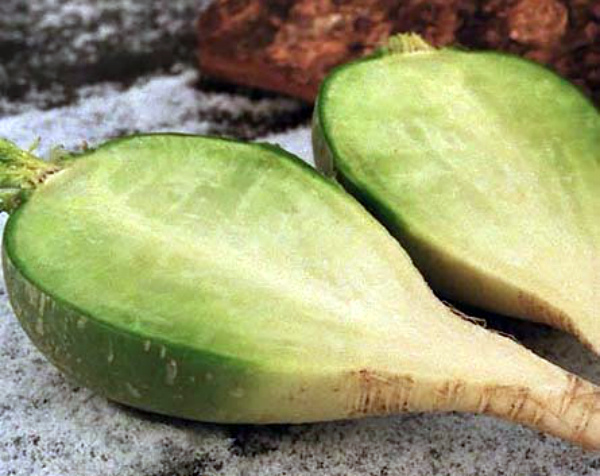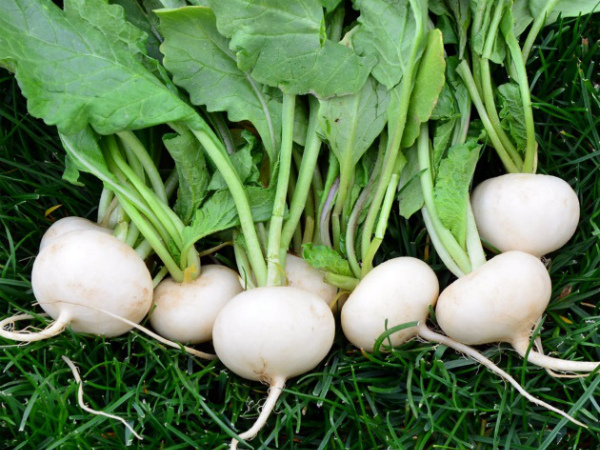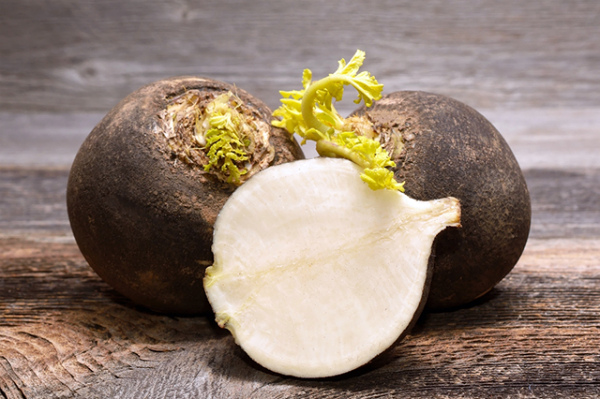Varieties and types of radish: early maturing and late maturing
Radish roots can vary in size, shape and color. Here and winter round white, red and purple radish, yellow, black and green radish (although the pulp of all varieties of radish are white). The main types of radish are summer and winter radish.
Content
Early ripening
It is generally believed that the radish is a biennial plant. However, early maturing and early maturing varieties are more likely to be annuals, since they may well shoot in the first year of growth. They do everything so quickly that they can have time to bloom and ripen in one season, if they are allowed to.
All early varieties of radish are not intended for long-term storage, they are consumed for several days after harvest. Summer varieties mature in a short period of time from 30 to 60 days.
"Odessa 5"
One of the early ripening varieties most beloved by summer residents, it ripens in 30-40 days from the moment of sowing. The oval-conical root vegetable grows from 50 to 100 g in weight, its pulp is white, tender, juicy, very tasty. The yield is large - from 1 square meter you can get up to 7 kg of useful root crops, only he does not want to be stored at all, therefore it is not profitable to grow it for sale, it is best to eat it directly from the garden, then you can fully appreciate the pleasant somewhat spicy taste and get benefit.
"Green Goddess"
It is a young variety that is rapidly gaining popularity due to its qualities. The correct round shape and green color of the radish make it look very impressive. The small content of mustard oils makes its taste rather soft, slightly pungent. The root vegetable contains amino acids, mineral salts and trace elements that are easily absorbed, which allows the vegetable to be included in therapeutic diets. Breeders have especially tried to increase the shelf life, so that the crop can be stored for a long time or transported from place to place without loss of quality.
"Maiskaya"
It is famous for its oval juicy white roots with a mild taste. It ripens in 50-60 days, but it cannot be stored for a long time, so it should be consumed immediately.
"Summer round white"
Ripens 40–45 days after sowing. Juicy tasty root vegetables grow from 70 to 100 g in weight, but they must be removed immediately - ripe root vegetables left in the ground can rot or form a hollow inside. When growing this variety, you need to determine exactly how much time to take for ripening, so as not to get a spoiled crop, and it can only be recognized empirically.
"Sudarushka"
It ripens in about 40 days and is usually planted in summer, but will grow beautifully if sown in spring or even fall. A very tasty large turnip sticks out half of the ground, so it is easy to remove.
"Daikon" or "Japanese radish"
Pleasant taste, unpretentious care, medicinal properties, large size - this Japanese vegetable has a lot of advantages. A long root vegetable can grow up to 60 cm, and in diameter - up to 10 cm. One of the varieties - Misato - is painted pink, which looks elegant and unusual. At Daikon they eat not only the root vegetable, but all parts of the plant.
It is very important that this plant does not absorb harmful substances from the environment at all, it can be grown on the side of a busy highway or on the territory of a plant with harmful production, it will not accumulate any carcinogens or toxins.
The only inconvenience is that this variety can hurry to throw out the peduncle when daylight hours increase over 13-14 hours.
The word "daikon" is the name for all Japanese radish, but there are hundreds of varieties, some of which are even gigantic. The Japanese eat this vegetable not only raw, they salt it, boil it, pickle it, preserve it, emit bitter and sweet varieties.
Mid-season
Mid-ripening and late-ripening varieties belong to winter ones, their ripening begins from 80 days from the moment of sowing, it is among them that you need to choose vegetables for long-term storage.
"Wonderful" or "Wonderful"
The crop can be harvested in 80–90 days. The black round root vegetable grows on average up to 300–350 g. The flesh is white, juicy, very dense. Usually it is sown in mid-June so that it is fully ripe before the cold weather. It can lie all winter without losing its juiciness.
"Winter round white"
Ripens from 80 to 100 days. A round white root vegetable is elongated in an oval or flattened with a firm and juicy pulp that is quite pungent in taste. It is perfectly stored in a cellar for several months without losing its taste or benefits.
"Winter round black"
This very famous variety does not need to be introduced, it is considered the most useful among all relatives. Ripening occurs 110–120 days after sowing. The black skin is smooth or grooved, the juicy flesh is white with a slight pungency. Differs not only in good keeping quality, but also in excellent yield.
"Winter long black"
The roots are elongated, can grow up to 400 g, the pulp is fibrous, but juicy and crunchy. It remains the same after several months of storage.
"Margelan" or "Chinese"
It is also called "Lobo". This is not a very common variety so far in our country. He loves moisture and organic fertilizers. The antiseptic properties of the root crop, the ability to remove excess salts and cholesterol from the body can improve the health of many people. It tastes like any radish - spicy, juicy, well absorbed by the body, used in salads, well stored.
Late ripening
Late-ripening varieties ripen 100-120 days, all this time the radish requires care, no matter how unpretentious it may be. Of course, it is easier to sow an early-ripening variety, until the root crop is fully ripe, it will not tire the owner in any way (it simply will not have time), but only winter varieties can be laid for the winter.
"Gaivoronskaya"
The variety is not capricious, absolutely unpretentious, it is advised to grow it for novice gardeners. Its white cylindrical root crops are not afraid even of the autumn cold. The pulp is fibrous, firm and dense, the taste is pungent, the smell is strong. It can be stored for a long time, over time it becomes softer (to taste), but not very much. To add it to a salad, it is advised to leave the already chopped root vegetable in the fresh air for a couple of hours, but along with the pungency, some of the vitamins and essential oils will evaporate. Hot sauces and snacks are made from it, like horseradish.
"Gaivoronskaya 27"
This hybrid proves that it's not just the Japanese Daikon that can be huge. For 120 days from the emergence of shoots to the ripening of the crop, the root crop manages to grow up to 50 cm long and up to 2 kg in weight.Only, unlike the Japanese, we do not boil radish, but in pickled form, these root crops are beyond praise.
"Doctor"
The name reflects the high opinion of the creators about the usefulness of this radish. Black round roots weigh about 250 g, juicy, tender pulp.
Excellent yield, good keeping quality, excellent taste and a lot of useful properties make it possible to grow this variety for commercial purposes.
Video "Choosing a radish for planting"
This video will help you choose a radish variety for sowing, and also tell you about the timing of planting root crops.
What to choose
As a rule, after winter, all summer residents want to get a harvest of vitamin vegetables early. A radish is ideal for this purpose. White radish is considered the most spicy, it is rarely put in salads, and even then in small quantities. Most often, it is left for the winter, pickled, spicy sauces and snacks are made from it, it is it that is called bitter.
The black radish is not as spicy as it is considered to be the healthiest. Salads and medicinal tinctures are made from it, they are eaten in summer and winter. We grow Chinese and Japanese radishes that are not too spicy, they are also eaten in salads or pickled.
The earliest radish is planted in March, it is frost-resistant and is able not only to endure spring cold snaps, but even germinate at low temperatures. Here she also gets on our table in the spring. After April 25, early ripening varieties are sown, which give root crops in June. But later, in June, they plant those vegetables that are going to be stored for a long time, put in the cellar for the winter.
Video "Growing radish"
Thanks to this video, you will learn everything about growing radish: from sowing seeds to storing root crops.







